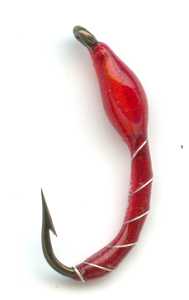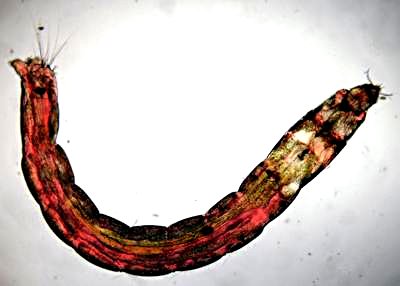Red Ribbed Epoxy Buzzer Midge Nymph
When there are midge bloodworm nymph drifting in the river or lake you are fishing then the Red Ribbed Epoxy Buzzer Midge nymph fly should be one of the fly patterns you choose to tie onto the end of a dropper.

EPOXY BUZZER MIDGE FLY PATTERNS. Hook size 14 12 - $US each
The single buzzers can be fished just bellow the surface by greasing all but the last three inches of the leader. If there is a single ripple, an occasional twitch of the fly line is enough to attract attention. In flat calm conditions it is usually better to fish the buzzer static in the surface film. An alternative tactic is to degrease the leader and allow the buzzer to sink very slowly. Using this technique you should be ready for takes 'on the drop', as a trout seizes the buzzer some distance below the surface. I have had many takes sitting this buzzer 2-4 feet below a dry fly used as an indicator and fished close to weed beds in shallow water. In winter this fly has excelled for me when trout are still taking buzzers as part of their diet.
Whether from boat or bank I try a floating line first thing in the morning. Over night many buzzers will have been on the water overnight and some may have even emerge in the early hours. Opportunist fish will often be close to the shore or river bank feeding high in the water after their surface activity. You will be sight fishing for moving fish as they cruise around the margins. A floating line with a team of epoxy buzzer nymphs imitating the pupae, with maybe a suspender buzzer or Shipman's buzzer on the top dropper. I use a larger heavier epoxy buzzer on the point. The top dropper can entice interest from any surface movement and attract any fish looking upwards. As soon as the fish stop showing in any numbers on the surface, and the buzzers have been plentiful, then the epoxy subsurface patterns come into play. (A 'Dropper' is a length of leader tied to the main leader on which other flies are added.)

The heavier buzzer on the point helps to get the flies down straight in the water as well as aiding turnover in the cast. I find it helpful to present a cast in a straight line. If the flies land in a heap they can often tangle and rarely fish well. Should this happen, in the breeze for example, then a long pull to straighten the leader can be tried. In deep water I use a floating line and a fast sinking Fluorocarbon type of leader material which is nearly invisible under the water. Sometimes the flies end up under the fish so I fish with a buoyant pattern like a Booby Nymph on the point to suspend the remaining flies higher in the water. I count the nymphs down for about 20 seconds before starting the retrieve. If I hit the bottom I do not immediately pull the line in and recast. If you are fishing more than one fly those still on the dropper are still available to tempt the trout. In these situations I just carry on retrieving slowly. In clear water I use leaders up to 18 foot long with thee flies spread about 6 foot apart. If they are too close together the trout may become suspicious. If you are a beginner I suggest that you start off with a 12 foot leader with one fly on the point and another placed 6ft up from there on a dropper. Some fishermen like to place a brash bright fly as 'disturbance' fly on the top dropper with epoxy buzzers behind. The fish often follow the top dropper but as they get near the boat or river bank see the more natural looking buzzer and reject the attraction of the top fly. If it is really windy just use one fly because the more flies you use the more tangles your risk
Bloodworm fishing for trout
Whilst on a late autumn business trip to Staffordshire I had an afternoon free following a morning meeting and decided to visit a local fishery. It had three spring fed lakes set in a mature country setting, surrounded by farmer’s fields, rolling hills and small woods. I asked at the lodge about what flies are producing results and was surprised to be told that bloodworms were on the trout’s menu this month.
That was fine with me. I had a few patterns in my box that would fit the bill. They included a red epoxy buzzer, an epoxy bloodworm, a bloodworm nymph and a red copper John. Which one should I try first? I set up a 4lb floating line. I tied on a single bloodworm nymph to start with that would cover the water at depth of 3 feet.
I spotted the small dam wall and noticed that it had a favourable crosswind that would help with casting this light set up. The wind would help keep the fly line away from my body. As I approach the bank near the dam I notice a feeder stream has turned the nearby water slightly coloured with visibility down to about 70%.
Through experience of fishing bloodworm patterns in the past I find the best results are always in gin clear water. You can still catch fish using a bloodworm but you would have better results with a black woolly bugger or a dark Viva Cats whisker streamer. I change position so I can cast to the clearer water area just around the edge of the discoloured section.
I get no interest during the first three casts. I move a couple of yards down the side of the small dam and find reward with a soft take. I apply a quick strike and the fish is on. It plays hard not giving an inch. As the fish draws nearer I can see that the hook is firmly set in its mouth. Eventually it comes near enough to be netted. I nice 2lb rainbow trout. What a great start to the day. The information that gave me at the lodge looks good.
That deserved a cup of celebration coffee from my flask and a bite of the sandwich I purchased at the motorway service station on route to the fishery. It had been a sunny morning but as I sat on the lakeside bench the clouds moved in and the temperature dropped as a chilly wind started to blow. No more sunshine. Well at least it was not raining.
I continued to fish my successful rainbow catching red bloodworm fly. Cast after cast nothing, not even a nibble. There was no visible activity on the lake surface. I zipped up the collar of my jacket as I started to feel the change in the weather. It then dawned on me. What an idiot. If I was feeling the cold then so were the fish. What do trout do when the weather turns colder? They go deeper.
My problem now was to try and work out what depth to fish. This called for a team of flies to search out the trout’s preferred location. I selected a beaded red copper john nymph as the weighted beaded point fly and added a red suspender nymph on the top of the rig to float on the surface and act as a strike indicator. I choose a red epoxy nymph as the middle dropper as its slim body would help get it to the required depth quickly.
Standing on the bank I made a cast to the 10 o’clock position. After allowing a couple of seconds for the subsurface flies settle I then gave them a very jerky, flicking style of retrieve to try an imitate the way natural blood-worms try to move in the water by stretching their bodies. I have found in the past that this tactic can produce some great responses from the lurking trout.
Bloodworm flies can be fished by letting the wind form a curve in the line but I have found that less fish fall to this style. If you are fishing in strong Windsor the trout are holding on the bottom try using a fast-sinking line with a 10ft leader. In these cases still use a jerky retrieve but be careful not to move your fly too quickly, keep it slow. If you get no take be prepared to shorten the leader so you fish a different depth. Shorten it two feet at a time.
I located the feeding depth the rainbows had swam down to after an hour of searching and testing. The second fish of the day took my point fly at the depth of 6 feet. After another 20 minutes of casting I caught my third fish at the same depth. This was a fine 3lb rainbow. My last trout of the afternoon took my red epoxy nymph just as I was about to take the line out of the water. I think it must have followed it up. What a great way to enjoy yourself on a business trip.



